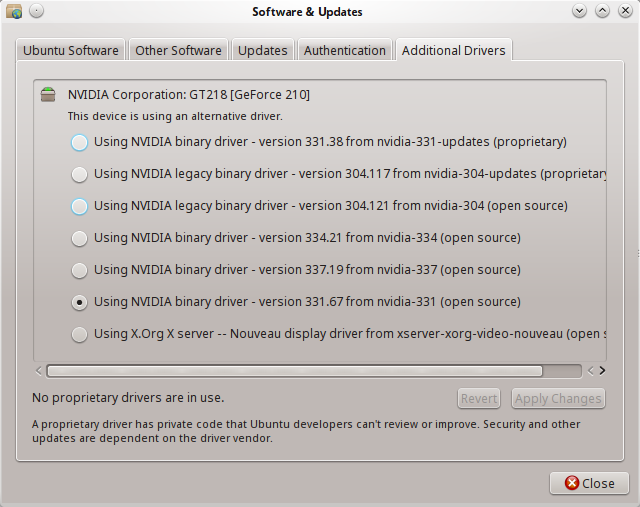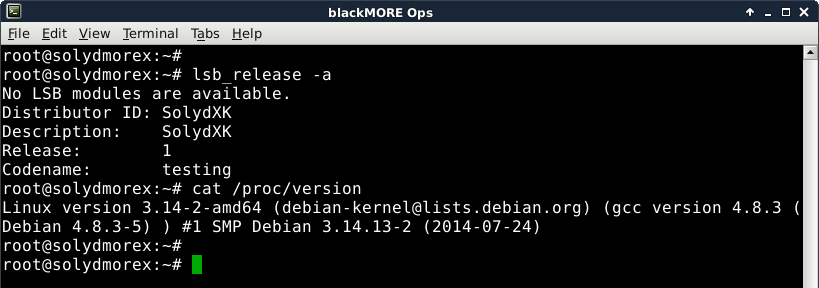How To Install Ati Drivers Ubuntu Terminal
Windows needs manufacturer-provided hardware drivers before your hardware will work. Linux and other operating systems also need hardware drivers before hardware will work — but hardware drivers are handled differently on Linux.
The good news is that, if a device will work on Linux, it’ll probably “just work” out of the box. You may sometimes need to install drivers, but some hardware may just not work at all.
How to install ATI Radeon HD 2600 drivers in Ubuntu. Select the first option, then click next, then use all the reccomended options. When finished, restart your computer. To get sound working right click on the sound icon on the top right, click sound preferences. Go to Output and select the RV630 or whichever your one is.
How Hardware Drivers Work on Windows
When you install Windows, you’ll need to install hardware drivers provided by the hardware’s manufacturer — motherboard chipset drivers, graphics card drivers, Wi-Fi drivers, and more.
RELATED:Should You Use the Hardware Drivers Windows Provides, or Download Your Manufacturer’s Drivers?
Windows does try to help. Microsoft bundles a lot of these manufacturer-provided drivers with Windows, and hosts many of them on Windows Update. When you plug in a new device to your Windows computer and you see the “Installing Driver” bubble pop up, Windows might be downloading a manufacturer-provided driver from Microsoft and installing it on your PC. Microsoft doesn’t write these drivers on its own — it gets them from the manufacturers and provides them to you after vetting them.
If hardware isn’t working on Windows, there’s usually a driver to make it work. Unless you have an ancient device that only works with older versions of Windows, the manufacturer has done the work of making it work with Windows. Hardware that doesn’t work is usually just a quick driver download away from working.
How Hardware Drivers Work on Linux
Things are different on Linux. Most of the drivers for hardware on your computer are open-source and integrated into Linux itself. These hardware drivers are generally part of the Linux kernel, although bits of graphics drivers are part of Xorg (the graphics system), and printer drivers are included with CUPS (the print system).
Install Ati Drivers Ubuntu Terminal
That means most of the available hardware drivers are already on your computer, included along with the kernel, graphics server, and print server. These drivers are sometimes developed by hobbyists. But they’re sometimes developed by the hardware manufacturer themselves, who contributes their code directly to the Linux kernel and other projects.
In other words, most hardware drivers are included out-of-the-box. You don’t have to hunt down manufacturer-provided drivers for every bit of hardware on your Linux system and install them. Your Linux system should automatically detect your hardware and use the appropriate hardware drivers.
How to Install Proprietary Drivers
Some manufacturers to provide their own, closed-source, proprietary drivers. These are hardware drivers that the manufacturers write and maintain on their own, and their closed-source nature means most Linux distributions won’t bundle and automatically enable them for you.
Most commonly, these include the proprietary graphics drivers for both NVIDIA and AMD graphics hardware, which provide more graphics performance for gaming on Linux. There are open-source drivers that can get your graphics working, but they don’t offer the same level of 3D gaming performance. Some Wi-Fi drivers are also still proprietary, so your wireless hardware may not work until you install them.
How you install proprietary drivers depends on your Linux distribution. On Ubuntu and Ubuntu-based distributions, there’s an “Additional Drivers” tool. Open the dash, search for “Additional Drivers,” and launch it. It will detect which proprietary drivers you can install for your hardware and allow you to install them. Linux Mint has a “Driver Manager” tool that works similarly. Fedora is against proprietary drivers and doesn’t make them so easy to install. Every Linux distribution handles it in a different way.
How to Install Printer Drivers
You may need to install drivers for printers, however. When you use a printer-configuration tool to configure CUPS (the Common Unix Printing System), you’ll be able to choose an appropriate driver for your printer from the database. Generally, this involves finding your printer’s manufacturer in the list and choosing the model name of the printer.
You can also choose to provide a PostScript Printer Description, or PPD, file. These files are often part of the Windows driver for PostScript printers, and you may be able to hunt down a PPD file that makes your printer work better. You can provide a PPD file when setting up the printer in your Linux desktop’s printer configuration tool.
Printers can be a headache on Linux, and many may not work properly — or at all — no matter what you do. It’s a good idea to choose printers you know will work with Linux the next time you go printer-shopping.
How to Make Other Hardware Work
RELATED:10 of the Most Popular Linux Distributions Compared
Occasionally, you may need to install proprietary drivers your Linux distribution hasn’t provided for you. For example, NVIDIA and AMD both offer driver-installer packages you can use. However, you should strive to use proprietary drivers packaged for your Linux distribution — they’ll work best.
In general, if something doesn’t work on Linux out-of-the-box — and if it doesn’t work after installing the proprietary drivers your Linux distribution provides — it probably won’t work at all. if you’re using an older Linux distribution, upgrading to a newer one will get you the latest hardware support and improve things. But, if something isn’t working, it’s likely that you can’t make it work simply by installing a hardware driver.
Searching for a guide to making a specific piece of hardware work on your specific Linux distribution might help. Such a guide might walk you through finding a manufacturer-provided driver and installing it, which will often require terminal commands. Older proprietary drivers may not work on modern Linux distributions that use modern software, so there’s no guarantee an old, manufacturer-provided driver will work properly. Linux works best when manufacturers contribute their drivers to the kernel as open-source software.
In general, you shouldn’t mess with hardware drivers too much. That’s the vision of Linux — the drivers are open-source and integrated into the kernel and other pieces of software. You don’t have to install them or tweak them — the system automatically detects your hardware and uses the appropriate drivers. If you’ve installed Linux, your hardware should just work — either immediately, or at least after you install some easy-to-install proprietary drivers provided by a tool like the Additional Drivers utility in Ubuntu.


If you have to hunt down manufacturer-provided proprietary drivers and extended guides for installing them, that’s a bad sign. The drivers may not actually work properly with the latest software in your Linux distribution.
Image Credit: Blek on Flickr
AMDGPU-PRO is AMD’s proprietary driver for its latest graphics cards. That means that it mainly covers the Polaris cards, the RX 4XX series and the RX 5XX series. It does work with older cards too, but they won’t see as much continual improvement and development.
Like its name suggests, AMDGPU-PRO is intended for professional use. Don’t worry. You can absolutely game with these drivers. AMD branded them for workstation users. As a result, AMD only releases the AMDGPU-PRO drivers for long-term support (LTS) releases and “Enterprise” distributions. For Ubuntu this means that you can only install these drivers on the latest LTS release. In this case, it’s 16.04.2.
Running an LTS release has some drawbacks. For starters, you won’t get the latest releases of new software on your system. You will get security fixes and some backports. You can get around a lot of these constraints in other ways, like importing applications such as Firefox from other releases, but it can be a pain to do so.
If you don’t want to run the LTS release or you already aren’t, you can always install the open-source AMDGPU drivers. In the latest releases of Ubuntu, they may even work out of the box, depending on your card. The open-source drivers don’t get all the new features of the proprietary ones, though, and are lacking in Vulkan support.
Getting the Packages
So you’ve chosen the Pro drivers. How do you get them? Since these drivers are AMD’s territory, they aren’t available in the Ubuntu repositories. You have to go to AMD’s website to download them.
Open your browser and head over to the release notes on AMD’s website. Once you’re there, scroll down to the section that starts with, “The AMDGPU-Pro Driver can be downloaded…” The link for Ubuntu will be right below. Click it to download the drivers in a tar archive.
Navigate into your download folder and unpack the archive.
Your version number may be different depending on when you’re reading this, so make sure to use the right one.
Unpacking the archive will give you a folder with the same name. Change into the folder and get ready to install.
Installing AMDGPU-PRO
Once you’re in the folder, take a look around.
There are a lot of .deb packages in there. AMDGPU-PRO is odd when it comes to proprietary drivers on Linux. In the past proprietary graphics drivers just contained some Linux kernel modules to interact directly with the kernel and the drivers themselves. This is still the way that NVIDIA does it.
AMD took a very different approach recently. All of AMD’s drivers are tightly integrated with the open-source software that makes graphical displays on Linux possible. There are a number of parts in that chain including the kernel itself, the Xorg Server, and direct rendering managers. AMDGPU-PRO is the open-source AMDGPU but with added bits that AMD doesn’t want to open-source yet.
Because AMD doesn’t want to open-source all of this code, they had to take over maintaining their own versions of the open-source packages that the drivers rely on to ensure that everything works well. That’s why there are so many packages with the driver. When you install the AMDGPU-PRO drivers, you are replacing the Ubuntu versions of your graphics packages with the AMD ones. They’re essentially the same, but this gives AMD a controlled environment to ensure that the drivers work perfectly.
Now for the simple part: AMD has included a convenient script to install everything for you in the folder. Just run the script with sudo.
The script will run and install all of the packages that are required for your system. If you want it to ask you questions during the install, leave the “-y” off the end. That’s just there for convenience, and it’ll work fine most of the time.
When the script is done, restart your computer and enjoy your new drivers!